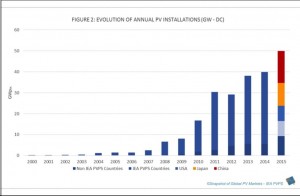The growth of large scale photovoltaic electricity in the United States
Essay by S. Tom Bond, Resident Farmer, Lewis County, WV, May 4, 2017
Solar electricity generation is expanding far more rapidly than burning fossil fuels, because the cost is decreasing rapidly and because of global warming concerns. Both home installations and large scale photovoltaic generation are progressing rapidly according to a recent article in Science, the journal of the American Association for the Advancement of Science.
Installation costs in 1976 were over $90 per watt, but had fallen to 90 cents per watt by 2015. The installed volume has gone from about 750,000 kilowatts in1976 to 220 gigawatts (thousand kilowatts) in 2015. The curve is exponentially up, meaning each year’s increase is greater than the previous year.
Driving the increase is both improvements in the technology of the solar cells and improvements in manufacturing. A regular reader of Science notes developments in the efficiency and longevity of solar cells almost every month. Elsewhere we read that China, with its terrible environmental problems, is placing great emphasis on solar and has become the country with largest photovoltaic use, starting in 2015.
The article says, “Grid-integration technologies and flexibility options available today should enable at least 25% to 40% variable renewable energy (solar and wind) with feasible cost and stability.” Some engineering changes in procedure would be necessary, such as heating water at a time of day the energy is available.
Both solar and wind would benefit from electrical storage. The most efficient storage available is lithium-ion batteries. These are being developed for use in electrical automobiles, and the same size is suitable for home electrical storage. If the car stays in the garage (such as at night) the same battery can be used for both. Lithium-ion batteries are expected to come into use in the 2020’s.
The authors of the Science article predict storage of electricity for less than 2.5 cents per kilowatt by 2030. They state solar power at 3 cents per kilowatt-hour and storage at even 5 cents per kWh would be economically competitive by 2030. The solar industry is on a trajectory to reach this.
There are many things going on now that hurt the demand for fracked gas, but the public is largely unaware of them. One is a decline in the price of oil, due to the Saudi Arabia discovery that they did not need such a high price for their oil. Another is the fact the ACP and MVP pipelines, both 42 inch and operating at near 100 times atmospheric pressure at a maximum, passing through Virginia have attracted a gubernatorial candidate who is campaigning against them. Doubtless due to their widespread unpopularity.
Still another is the fact several huge chains, including Walgreens, Costco, Kohl’s, Ikea and Walmart are adopting solar on their roofs. Still another is whole cities planning to go all renewable. Atlanta becomes the 27th city to commit to 100% renewables.
The prospects for wind power also look very good.

